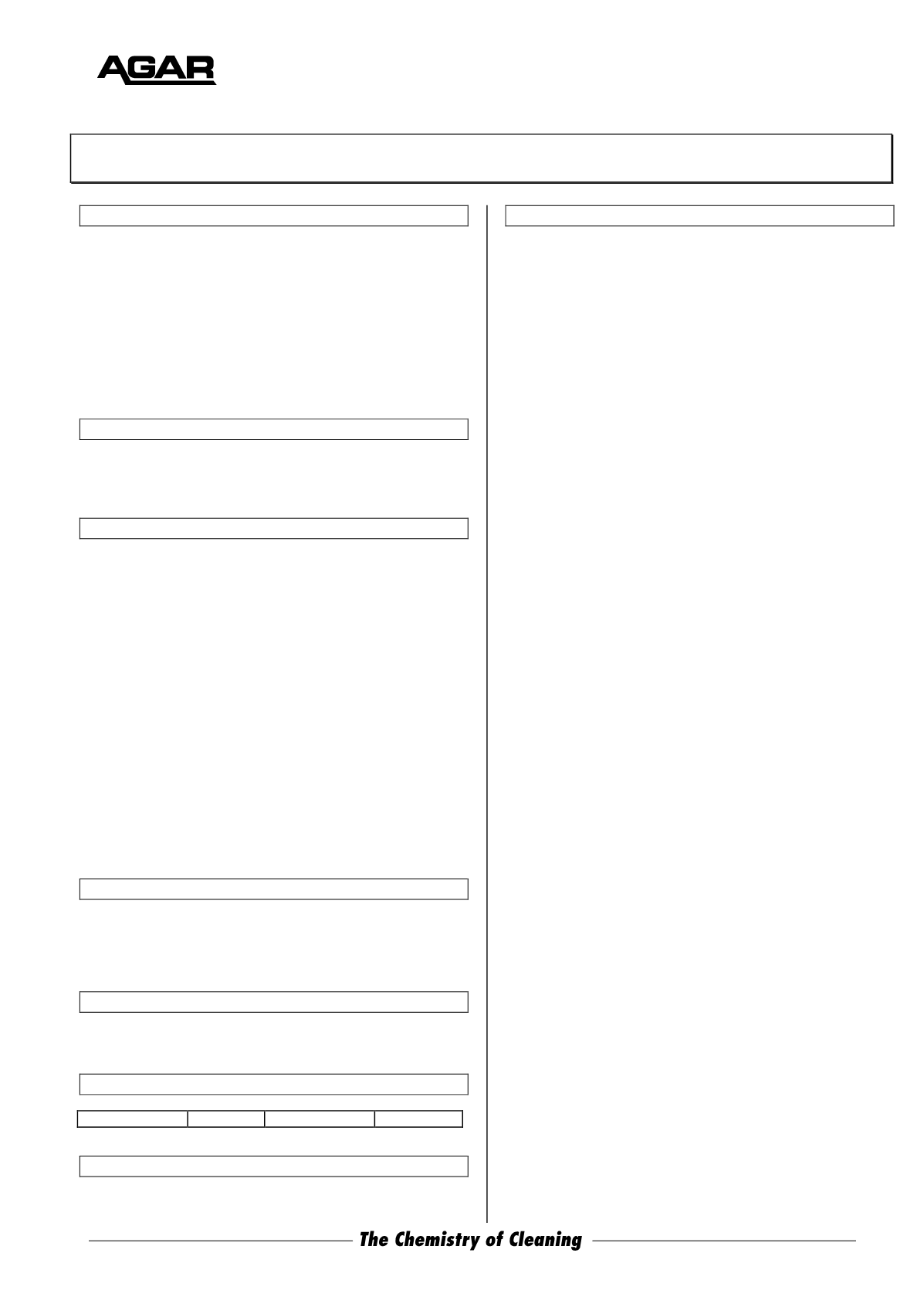

ABN 80 004 726 890
MADE IN AUSTRALIA
Safety Data Sheet
Issued: April 14, 2011
Page 2 of 2
COFFEE STAIN REMOVER – PART A
9 PHYSICAL AND CHEMICAL PROPERTIES
Appearance: Transparent colourless liquid
Odour: Strong ammonia odour
pH = 12.1 – 12.6
Vapour Pressure: N/K
Vapour Density: N/K
Boiling Point: 100
°
C
Freezing Point: < 0
°
C
Solubility in water: Infinitely miscible
Specific Gravity: 1.02
Evaporation rate: As water
% Volatile by vol: 90 - 95%
10 STABILITY AND REACTIVITY
Stable.
Hazardous polymerization: None.
11 TOXICOLOGICAL INFORMATION
Health Effects:
Acute -
Swallowed: Product may be slightly irritating to the gastro-
intestinal tract if swallowed.
Eye: Eye contact may result in stinging and slight irritation.
Skin: Principal route of exposure is usually by skin contact.
Irritating to the skin and capable of causing skin reactions.
Repeated or prolonged skin contact may cause swelling,
redness, blistering or dermatitis.
Inhalation: Inhalation of vapours in confined spaces may cause
slight irritation to mucous membranes.
Health Effects –
Chronic:
None known.
Toxicity data: Not available for mixture.
Data for main ingredients:
ammonia – oral LD50 (rat) = 350 mg/kg
(Note: this data is from published information. Agar Cleaning
Systems does not carry out animal tests).
12 ECOLOGICAL INFORMATION
Ecotoxicity: No data available.
Persistence and degradability: -
Mobility: -
Advice: Prevent entry to natural waterways.
13 DISPOSAL CONSIDERATIONS
For disposal, refer to State Land Waste Management Authority.
14 TRANSPORT INFORMATION
UN No.: - not reg Class: -
Packg.Group: - Hazchem: -
15 REGULATORY INFORMATION
Poisons Schedule Number: Schedule 5.
16 OTHER INFORMATION
AICS Listing:
All components of Coffee Stain Remover Part A
are listed on the Australian Inventory of Chemical Substances
(AICS).
Date: This SDS issued: April 14, 2011
Abbreviations and Definitions of terms used:
<
less than
>
greater than
AICS
Australian Inventory of Chemical
Substances
CAS
Chemical Abstracts Service (Registry
Number)
COD Chemical Oxygen Demand
deg C Degrees Celsius
g
gram
g/L grams per litre
HSIS
Hazardous Substance Information System
kg
kilogram
L
Litre
LC50
The concentration of a material (inhaled)
that will be lethal to 50% of the test animals.
LD50
The dose (swallowed all at once) which is
lethal to 50% of a group of test animals.
m3
Cubic metre
mg
milligram
mg/m3 milligrams per cubic metre
miscible A liquid that mixes homogeneously with
another liquid
N/A
Not applicable
N/K
Not Known
NIOSH
National Institute for Occupational Safety
and Health
non-haz Non- hazardous
PEL
Permissible Exposure Limit
ppb
Parts per billion
ppm Parts per million
STEL Short term exposure limit
TLV
Threshold Limit Value
TWA
Time Weighted average
UN
United Nations (Number)
wt
weight
The information in this Data Sheet is based on our present
knowledge. However, this shall not constitute a guarantee for
any specific product features and shall not establish a legally
valid contractual relationship. Agar Cleaning Systems accepts
no tortious or contractual liability for any loss or damages
suffered as a consequence of reliance on the information and
advice contained herein.
End of SDS.


















